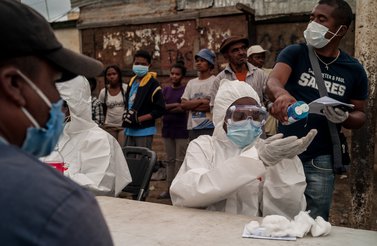The COVID-19 pandemic is accelerating global digital transformation and the adoption of digital technologies. It is also enacting a political and cultural shift toward a quantified society: a society in which measurement and predictive modelling dominate (political) decision making, and where surveillance is expansive and pervasive.
While viruses and disease have always been with us, what’s changing is our ability to measure and understand them. This ability comes at a time when globalization (and, by extension, climate change) has transformed the kinds of viruses and diseases we will face.
The knowledge of what can kill us — or is killing us — compels governments and health authorities to both take action in response and gather more data to understand the threat. Like many disasters or other globally impactful events, the COVID-19 pandemic is accelerating the development and implementation of quantification technologies.
Health researchers are now measuring the spread of a virus across the population in ways not previously possible, through the use of a set of data that is ever-growing, especially in countries such as China that have less regard for personal privacy. Canada and the United States are not yet conducting tracking and tracing of infections at a level that would enable containment. This level, however, is due to inadequate staffing rather than insufficient data. Still, the desire for more information remains.
As a result, our ability to measure human health and disease transmission is set to reach new records and capabilities. Through sources ranging from individuals’ use of digital health tools to contact-tracing records, health-related data is amassing at a prodigious rate.
What are the impacts or consequences of this dramatic increase in both health data and the perceived value or urgency of that data?
On an immediate level, the pandemic is changing how we identify and understand a virus and the disease it causes. Globally, we have an unprecedented capacity to identify and mobilize in response to an outbreak.
However, the conundrum is that we can observe but not control; we can respond, but we’re a long way from being able to prevent.
There is already growing criticism that the predictive models being used to set pandemic response policy are not as transparent nor as accurate as they need to be.
Similarly, relying on such complicated and abstract data radically reduces potential participation in decision making. The public disengagement that results has already created problems in translating public health guidance into citizen acceptance and compliance. The surge in infections in late 2020 and early 2021 in Canada, for example, is partly due to people making up their own minds and foregoing the advice of public health authorities to refrain from holiday social gatherings.
Whether we’re trying to combat a conspiracy theory or make sense of data-driven dashboards, we — individual citizens and, in particular, our elected officials — need to understand that data and improve our data literacy. As data proliferates, that need becomes increasingly urgent.
Similarly, the need for greater (and safer) digital infrastructure becomes clear. A national health data infrastructure could maximize the use of health data, increase both health and data literacy, and improve citizen participation, while also protecting privacy and data.
However, creating a national health data infrastructure would only confirm concerns that pandemic-based surveillance will be permanent. Not only do most current pandemic surveillance measures not have “sunset clauses” that would allow expanded data collection initiatives to expire, but they are designed to identify possible infection and outbreak, creating the capacity to identify future threats, and thereby justify their use.
These measures are not just contact-tracing apps, but information collected about travellers, location data collected by mobile providers, and health data collected by a myriad of private sector apps that are flourishing in response to the current pandemic.
It’s not just health data that is proliferating. As a result of the pandemic, surveillance in the workplace and in learning environments is also expanding dramatically. This includes automated software to track the productivity and attentiveness of remote workers, as well as similar software that tracks how students attend class or complete assignments and evaluations.
At a moment when our society relies on data of a complexity and at a scale never experienced before, we are reminded that the security and integrity of that data remains dubious.
Surveillance is not the only source of data, as companies have also rapidly embraced digital transformation as they adapt to remote work and digital marketplaces. While not literally a form of surveillance, digital transformation does result in heightened organizational data collection and use. Individuals working or isolating at home are also immersing themselves in digital social environments and online marketplaces that gather data about their interests and activities.
Ironically, this dramatic explosion of data is not only ushering in the quantified society but coming at a time when possibly the largest and most significant hack in history has been disclosed. At a moment when our society relies on data of a complexity and at a scale never experienced before, we are reminded that the security and integrity of that data remains dubious.
This makes the rise of the quantified society increasingly contentious and divisive. According to the Pew Research Center, the “majority of Americans feel as if they have little control over data collected about them by companies and the government.” While the Government of Canada is in the process of upgrading the country’s privacy laws, there is similar concern among Canadians that their privacy and liberty are at risk.
As we enter the next and perhaps darkest stage of this pandemic, democratic societies must consider a few important questions: How does increasing quantification impact government and society? How does knowing (in the form of having data) change our responsibilities to act? And how does the increasing role of data-driven decision making in government disenfranchise citizens who either do not have access to that data or the literacy to make sense of it?




